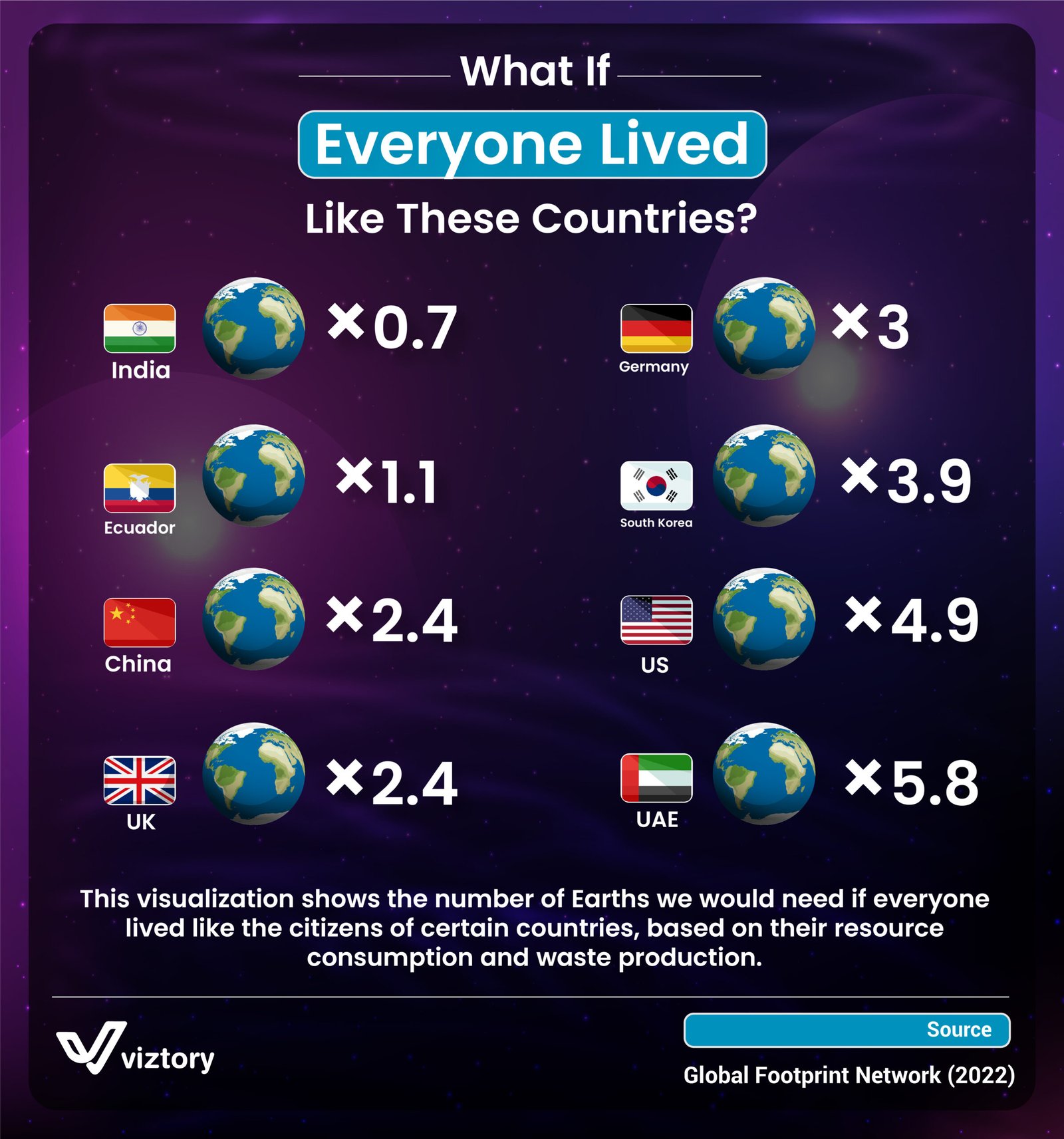What If Everyone Lived Like These Countries
-
Sep, Thu, 2024
What If Everyone Lived Like These Countries?
This visualization illustrates the number of Earths we would need if everyone on the planet lived like the citizens of specific countries, based on their resource consumption and waste production. It highlights the stark differences in environmental footprints across nations, reflecting varying levels of industrialization, lifestyle, and economic development. The disparity in resource consumption between countries is a crucial issue, especially as technology advances and affects both industry and everyday usage patterns.
Resource Consumption and Global Footprints
-
India: With a footprint of 0.7 Earths, if the global population adopted India’s consumption patterns, we would be living within the planet’s capacity. India, with its lower industrial output per capita and modest consumption levels, reflects a more sustainable lifestyle, but one also marked by challenges in access to technology and infrastructure.
-
Ecuador: Slightly above India, Ecuador’s footprint of 1.1 Earths suggests a balance between resource consumption and ecological sustainability, reflecting its lower industrialization compared to Western countries.
-
China and the UK: Both China and the UK would require 2.4 Earths to sustain their current levels of consumption. China, with its rapid industrialization, growing middle class, and massive technological expansion, is consuming resources at an accelerating pace. The UK, with its advanced technology sector and consumer-driven economy, mirrors this high level of consumption.
-
Germany and South Korea: More developed countries like Germany and South Korea, with footprints of 3 and 3.9 Earths respectively, are major contributors to global consumption due to their advanced technology, industrial sectors, and high standard of living.
-
United States: The U.S. has one of the highest environmental footprints, with 4.9 Earths. The American way of life, driven by heavy technology use, mass consumption, and widespread industrialization, reflects an unsustainable pattern of resource use that would strain the planet if adopted globally.
-
United Arab Emirates (UAE): With the highest footprint on the chart at 5.8 Earths, the UAE represents a resource-intensive lifestyle characterized by rapid urbanization, technological expansion, and the energy demands of desert living, all while relying heavily on imported goods and energy resources.
Technology’s Role in Resource Use and Industrial Impact
Technology is a double-edged sword when it comes to resource consumption and industrialization. On one hand, advancements in technology have vastly improved efficiency in industries like manufacturing, agriculture, and energy. Automation, artificial intelligence, and renewable energy technologies have the potential to reduce waste and lower environmental footprints.
However, as technology expands, especially in highly developed nations, it also drives higher consumption of resources. The global tech boom has led to increased demand for rare minerals, energy, and advanced materials. The production of smartphones, computers, electric cars, and other technological devices requires substantial energy and resource inputs, contributing to the larger footprints seen in countries like the U.S. and South Korea.
Moreover, technology has enabled mass production and consumerism, particularly in developed nations. Fast fashion, high-tech appliances, and luxury goods are now available on a global scale, further straining natural resources. This is evident in the high footprints of industrialized nations, where the demand for technology and modern conveniences outweighs the ecological impact.
Industrialization and Sustainable Usage
While technology has driven industrial progress, it has also led to unsustainable patterns of resource use. Countries like China, which have rapidly industrialized, show how increased technological capacity has led to higher resource consumption. Conversely, countries like India, which have lower technology penetration, show a smaller ecological footprint, though often at the expense of living standards.
The challenge moving forward will be to balance technological advancement with sustainable practices. Green technologies, such as renewable energy and circular economies, offer solutions that can reduce the strain on the planet. Nations must focus on utilizing technology to not only drive economic growth but also to ensure resource efficiency and sustainability.
Conclusion
The disparity in global ecological footprints, as illustrated in the visualization, underscores the need for more sustainable consumption patterns, particularly in highly industrialized countries. While technology has the potential to reduce waste and improve efficiency, its unchecked growth and the demand it creates for resources pose a significant threat to the planet’s ecosystems. To reduce global resource consumption, countries must leverage technology to develop more sustainable industries and promote responsible usage at both the industrial and individual levels.

